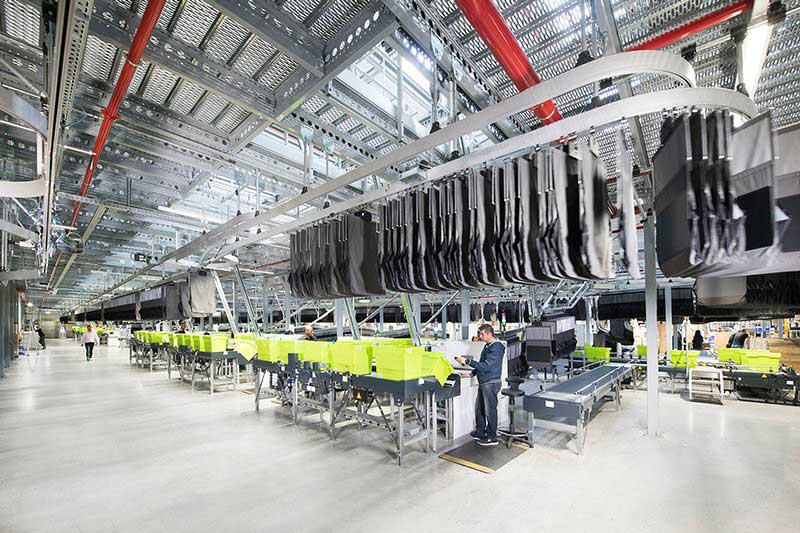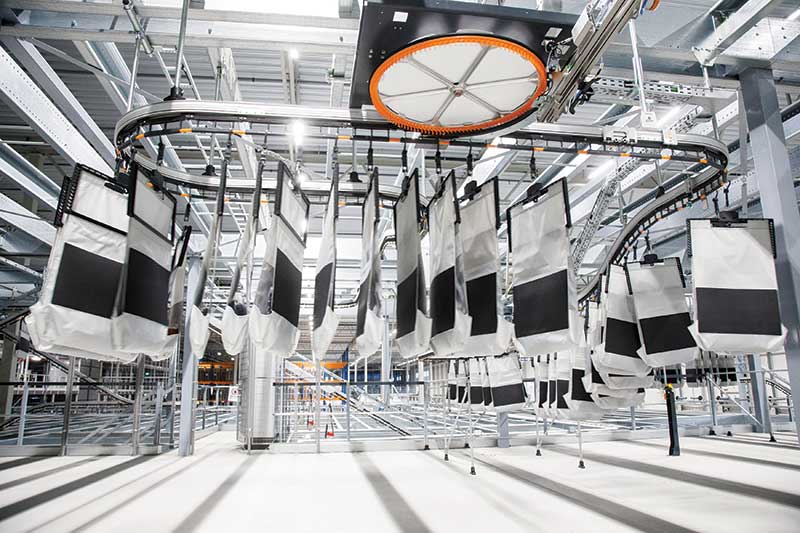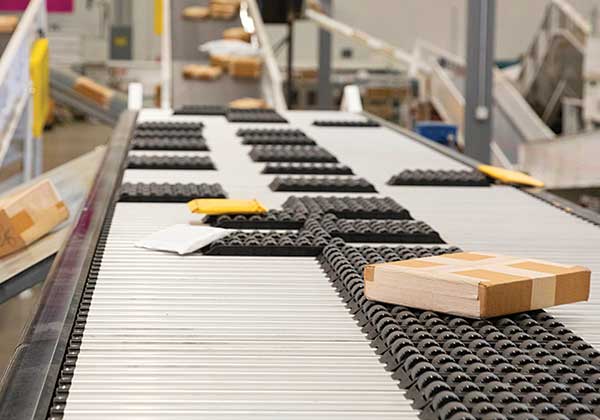Pocket sortation’s many efficiencies
Pocket sorters excel at buffering, sequencing, as well as sortation, making them a good fit for companies trying to pull off highly efficient order consolidation for store and e-commerce orders—as well as put returned goods right back into the fulfillment flow.

Got a high volume of goods for both store replenishment and e-commerce orders in your order pool and need to batch pick to gain efficiencies, while doing order consolidation in one automated system? That may sound like a tall order, but all these needs fall into the wheelhouse of pocket sortation systems, also known as pouch sorters.
While pocket sortation solutions can be a major investment and aren’t yet widely deployed, they are gaining interest because they can do more than sort, observes Robert Humphry, executive vice president with SDI Element Logic.
“The highest-level definition of a pouch sortation is a solution that uses an overhead track system to store, sequence and sort single items,” says Humphry. “What makes them unique compared with most other sortation approaches is that for large systems, they can be very economical, not only when it comes to transportation and conveyance, but they can store, sequence and sort goods, and they do all these things very accurately and cost effectively.”
In sectors such as retail apparel distribution, pocket sortation’s blend of conveyance, buffering, sequencing and sorting makes the technology a top investment to consider for omnichannel facilities that want to efficiently fill orders for stores, as well as pump out a high volume of smaller e-commerce orders from the same pool of inventory.
In particular, the ability of a pouch system to act as “sequencer,” says Humphry, allows goods to be buffered and organized with the system, and then sorted and conveyed to pack out in the order needed. Since a pouch system’s rails can be suspended from ceilings or other facility infrastructure such as racking, the systems can snake through multiple levels of a facility, which provides added room to buffer and sequence goods, create induction stations, and route goods to pack out, all while taking advantage of vertical space.

“The ability to use pouch sortation as multi-step sequencer allows an operation to gain enormous efficiencies compared with a more traditional sortation system,” says Humphry. “We find that it’s the most efficient and effective way to handle omnichannel needs—e-commerce and retail replenishment—in one warehouse.”
How they work
The buffering and sequencing functions allow inducted goods to be buffered, shuffled and dealt out to different orders as needed, while also handling returns, with these capabilities driving multiple benefits.
“When you are doing omnichannel and have orders that range from online orders with one to two lines per order, but you have store orders with way more order lines, and now want induct and handle some returns as well, it’s all pretty simple to do with pouch sortation. Whereas, trying to use traditional sorters, you might need multiple different process flows or sortation systems, which adds cost,” says Humphry.
Pocket sorters look much like the overhead handling systems found at your local dry cleaners, but with much more size and sophistication. For one thing, pocket sorters typically span multiple levels to make use of vertical height and accommodate all the buffering and sequencing the system needs to do, as well as routing sorted pouches to pack out stations.
Of course, not everything will fit in a pocket carrier. You are not going to fill orders for sofas with a pocket sorter, but they can hold a fairly wide variety of goods, especially apparel items, shoes or other retail goods that can fit into a pouch, which increasingly come in larger sizes.
For example, says Humphry, SDI Element Logic’s Joey pouches come in different sizes, including pouches that can hold 22 pounds. Pocket carrier mechanisms also allow for a garment-on-hanger to be attached to the carrier. Other types of carrier designs use clamps or hook fixtures to hold parts for manufacturing applications that call for some complex sequencing parts to work cells, which is another possible use for pouch sortation.
Companies that have deployed SDI Element Logic’s Joey pouch sortation solutions include Dillard’s and Stage Stores. Most systems, adds Humphry, make use of manual induction, but some special pouches have one hard side and an opening mechanism to support automatic induction. “The best fit tends to be in apparel distribution, but with the different sized pouches and carrier options, this technology can be used in other industries as well,” says Humphry.
Most deployments involve simulation of the needed buffering and sequencing lanes for the system, adds Humphry. A system also needs an empty pouch buffering area after pouches are emptied at pack out.
“Another area of benefit comes from the mechanical nature of how these systems work,” says Humphry. “Pouch sorters are able to leverage gravity really easily. With some systems, 80% or more of the movement is based on gravity, which reduces the energy and conveyance cost of the solution.”
Greg Meyne, senior director of automation with consulting company enVista, sees the multiple benefits to pouch sortation.
“There are two big advantages driving interest in pocket sortation,” says Meyne. “The first big advantage is that they function as an excellent order consolidation engine. You can have picks coming into the system from different areas in a facility—perhaps from a goods-to-person system but also from a pick module—and those picks can happen at different times. Once all the items needed to complete orders are in the system, pocket sorters do a great job at automatically bringing those full orders together.”
The second key advantage, adds Meyne, comes from labor efficient batch picks. “If you have created a system with 20,000 pockets, you can preload the buffering capacity in the sorter with picks that you know are going to be popular,” he says. “You can bring over a full case and induct it, so basically, pocket sortation will also speed up your picking.”
Returns processing engine
Pocket sortation systems can buffer large batch picks for popular SKUs and marry them up with other line items on incoming orders, and then tap the same buffering and sequencing capability to process returns efficiently, says Joe Shaw, manager of customer operational readiness with Dematic. This reduces touches and speeds up fulfillment, which is what many companies are after.
“Pouch sortation has a good future market, and a lot of that stems from the fact that today’s market requires everything to be faster,” says Shaw. “The push of Amazon and others has really accelerated the expectations in the e-commerce market, and that need to do things faster is something pouch sortation systems do very well, including with returns.”
Small parcel sorting remains a big challenge
Sortation systems increasingly
need to be able to handle a
broader range of parcels types,
from cartons to polybags.
Operations increasingly need to reliably sort small and micro-parcels to compact sort destinations.
The need to efficiently sort small parcels is a growing challenge, with more operations needing to process a high volume of orders in paper bags or polybags, says Bobby Uland, product portfolio manager for Fives.
With its GENI-Ride small parcel shoe sorter, Fives addresses this need with a design that differs from a traditional shoe sorter.
With GENI-Ride’s “RollerShoe” technology, the parcels ride on top of the system’s RollerShoe sections, which divert outward bilaterally at each sort destination with a destination possible every 28 inches.
The allows for rapid and reliable sortation of even lightweight parcels (capacity of 0.11 pounds to 15 pounds), with no chance of a thin polybag or micro-parcel getting trapped underneath.
To divert, each roller section rolls out to either side, depositing the parcel riding on top of it at the proper sort destination.
“Parcel sorters have historically been designed for standard six-sided boxes or cartons with flat, non-slip surfaces,” says Uland. “The advent and growth of e-commerce dramatically increased the breadth of item size and shape distribution, including much smaller, lighter and more slippery and dimensionally unstable items. GENI-Ride is designed for these smaller parcels, with the ability to sort at up to 15,000 pieces per hour.”
Another plus for the GENI-Ride is energy efficiency and quiet operation, notes Uland. “Consuming less than 10 kW power for a 400-foot sorter and operating at a lower noise level, it represents a more environmentally friendly option compared to traditional sorters, reducing the carbon footprint of logistics operations,” says Uland.
As soon as returns are inspected, those determined to be in new and saleable condition can be inducted in a pocket sorter and resold as a single item order or married up with other items in the sorter being inducted into it. The pocket sorter’s sequencing logic then takes care of the rest, notes Shaw, with no need for further steps or handling.
“With a pouch system, once you’ve processed a return and induct it back into the system as a saleable item, it’s now immediately a pickable item,” says Shaw. “That ability to get a return back in that morning, inspect it and induct it back into the system and out to a new customer in the afternoon, drives a lot of future potential for pocket sortation.”
Companies using Dematic’s pouch solution include Arvato SCM Solutions, a major 3PL in Europe that serves various industries. At its DC in Hanover, Germany, serving clients in the fashion industry, a Dematic pouch sortation system is the main system for order fulfillment, both for new items and vetted returns, which are inducted back into the system and held in the pouch system’s dynamic buffer where they can then be immediately leveraged to complete new orders.
The way pocket sorters can buffer large batch picks also helps with speed, says Shaw, because it reduces travel and labor on the picking side, with the sequencing logic able to consolidate the fast movers without other line items as needed, with no need for a secondary process, such as put walls. “Now you can be highly efficient with your batch picking processes and store the goods in the pouch system until complete orders are ready to go off to a packer,” says Shaw.
An emerging twist on pouch sortation, adds Shaw, is to add some automation at the final pack-out step. Pouch system designs have emerged that allow for automatic opening and emptying of the pouch, for example, so a packer doesn’t have to manually reach into the pouch. Or, for single line-item orders, it’s possible to have a pouch sorter automatically open and feed an item into an auto bagger.
“If you’re selling a lot of singles like apparel items, combining pouch sortation with auto bagger can provide even more efficiency, because now no one needs to touch those single items at the packing step,” says Shaw.
Future-proofing
There is growing interest in pocket sortation, agrees Jake Heldenberg, head of solution design, warehousing, North America, for Vanderlande, most often in e-commerce fulfillment and fashion/apparel DCs.
While pocket sorters have a lot of capability when it comes to buffering, sequencing and sorting items to pack out, all while making good use of vertical space, there are physical limitations to what can be conveyed in pockets or overhead carriers, notes Heldenberg.
“[Pocket sortation] fits fashion really well because the product mix happens to support easy induction into a pocket or conveyed as a garment-on-hanger item,” says Heldenberg. “We also see some use of that same type of overhead conveyance in the parcel market. Overall, the interest is driven by how well the technology can leverage vertical space.”
For smaller items well suited to pockets, says Heldenberg, a key advantage of pocket sortation is how it can buffer items inducted into the system using efficient batch picks, then hold those goods until needed to complete orders. The same holds true for buffering returned items and consolidating them with line items for new orders.
“There is a lot of functionality that pocket sortation enables, but it’s still kind of a niche in the sense that the products that can go in a pocket need to be relatively small items, or be fashion items, or relatively lightweight, or all three,” says Heldenberg.
Ultimately, it’s important to match any sortation choice to product characteristics and volume expectations, while also assessing how order profiles or SKU mix might change in the coming years, advises Heldenberg.
In some cases, a pocket sorter might be ideal, though in other cases where the future requirements are sure to involve a broader range of package dimensions, weights and package types, another choice like using cross-belt sortation might provide more adaptability.
“There is strong interest right now in future-proofing sortation, which we see in the requests we have coming in for cross-belt sorters,” Heldenberg says. “Companies are getting smarter about the fact that they need to have an investment that gives them flexibility for the future.”

Article Topics
Dematic News & Resources
Dematic FIRST Scholarship program applications open Dematic showcases VR experience for site simulation Talking Materials Handling: How data, software and hardware enable the future of supply chain warehouse operations Dematic and Groupe Robert open Quebec’s first fully automated cold storage facility Pocket sortation’s many efficiencies Dematic grants scholarships to five Grand Valley State University students Retail distribution closes in on the customer More DematicLatest in Materials Handling
Geek+ and System Teknik deploy PopPick solution for pharmacy group Med24.dk Beckhoff USA opens new office in Austin, Texas Manhattan Associates selects TeamViewer as partner for warehouse vision picking ASME Foundation wins grant for technical workforce development The (Not So) Secret Weapons: How Key Cabinets and Asset Management Lockers Are Changing Supply Chain Operations MODEX C-Suite Interview with Harold Vanasse: The perfect blend of automation and sustainability Consultant and industry leader John M. Hill passes on at age 86 More Materials HandlingAbout the Author
Subscribe to Materials Handling Magazine

Find out what the world's most innovative companies are doing to improve productivity in their plants and distribution centers.
Start your FREE subscription today.
April 2024 Modern Materials Handling

Latest Resources












